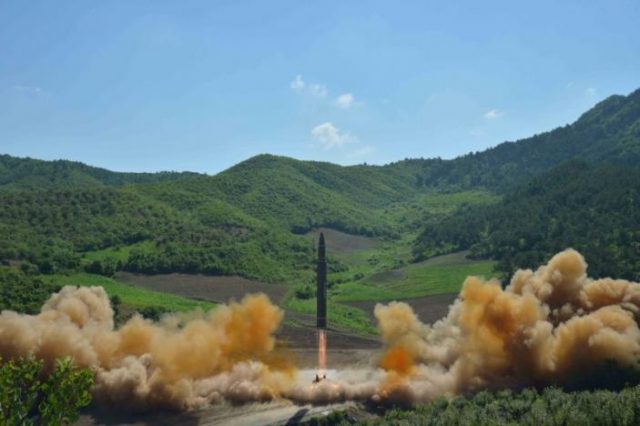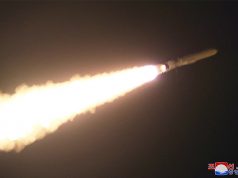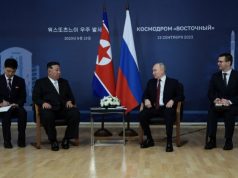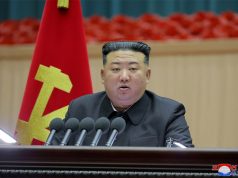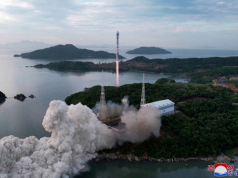SEOUL — North Korea said on Wednesday its newly developed intercontinental ballistic missile can carry a large nuclear warhead, triggering a call by Washington for global action to hold Pyongyang accountable for its pursuit of nuclear weapons.
A spokeswoman for the Pentagon said it had concluded that North Korea test-launched an ICBM, which some experts now believe had the range to reach parts of the mainland United States.
U.S. Secretary of State Rex Tillerson said the test, on the eve of the U.S. Independence Day holiday, represented “a new escalation of the threat” against the United States and its allies, and vowed stronger measures.
North Korean leader Kim Jong Un said the successful test completed his country’s strategic weapons capability that includes atomic and hydrogen bombs and ICBMs, the state news agency KCNA reported.
Kim said Pyongyang would not negotiate with the United States to give up those weapons until Washington abandons its hostile policy against the North, KCNA said.

“He, with a broad smile on his face, told officials, scientists and technicians that the U.S. would be displeased … as it was given a ‘package of gifts’ on its ‘Independence Day’,” KCNA said.
The launch took place days before leaders from the Group of 20 nations were due to discuss steps to rein in North Korea’s weapons program, which it has pursued in defiance of United Nations Security Council sanctions.
The test successfully verified the technical requirements of the newly developed ICBM in stage separation, the atmospheric re-entry of the warhead and the late-stage control of the warhead, KCNA said.
Tillerson warned that any country that hosts North Korean workers, provides economic or military aid to Pyongyang, or fails to implement U.N. sanctions “is aiding and abetting a dangerous regime.”
“All nations should publicly demonstrate to North Korea that there are consequences to their pursuit of nuclear weapons,” Tillerson said in a statement.
Diplomatic pressure
U.S. President Donald Trump has been urging China, North Korea’s main trading partner and only big ally, to press Pyongyang to give up its nuclear program. China is also the current chair of the U.N. Security Council.
Trump has indicated he is running out of patience with Beijing’s efforts to rein in North Korea. His administration has said all options are on the table, military included, but suggested those would be a last resort and that sanctions and diplomatic pressure were its preferred course.
Trump is due to meet Chinese President Xi Jinping and Russian President Vladimir Putin during the G20 in Germany this week.
Russia and China joined diplomatic forces on Tuesday and called on North Korea, South Korea and the United States to sign up to a Chinese de-escalation plan designed to defuse tensions around Pyongyang’s missile program.
“It’s discouraging that the Chinese (and Russians) are still calling for ‘restraint by all sides’, despite the fact that their client state North Korea has cast aside all restraint and is sprinting for the finish line in demonstrating a nuclear-armed ICBM capability,” said Daniel Russel, formerly Washington’s top diplomat for East Asia, now diplomat in residence at the Asia Society Policy Institute.
The U.N. Security Council will hold an emergency meeting on the matter at 3 p.m. EDT (1900 GMT) on Wednesday, following a request by the United States, Japan and South Korea.
Long-range missile
The North’s state media said the missile, Hwasong-14, flew 933 kilometers (580 miles), reaching an altitude of 2,802 kilometers (1,741 miles) over a flight time of 39 minutes.
Some analysts said the flight details suggested the new missile had a range of more than 8,000 kilometers (4,970 miles), which would put significant parts of the U.S. mainland in range, representing major advances in its program.
U.S.-based missile expert John Schilling, a contributor to the Washington-based North Korea monitoring project, 38 North, said the launch was both earlier and “far more successful than expected.”
He said it would now probably only be a year or two before a North Korean ICBM achieved “minimal operational capability.”
The U.S. and South Korean militaries conducted a ballistic missile test early on Wednesday in a show of force on the east coast of the Korean peninsula. The South said the drill was aimed at showcasing the ability to strike at the North’s leadership if necessary.
South Korean President Moon Jae-in, who ordered the drill, said “the situation was no longer sufficient to respond to the North’s provocation by making statements”, according to his office.
Tuesday’s missile test by the North poses fresh challenges for Moon, who came to office in May with a pledge to engage the North in dialogue as well as continuing to use pressure and sanctions to impede Pyongyang’s weapons programs.

